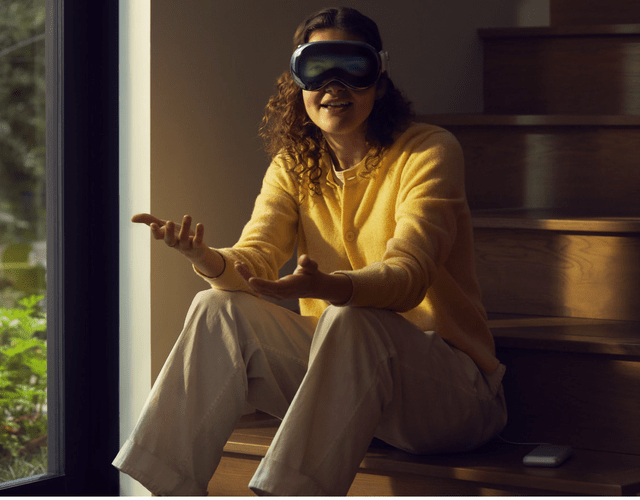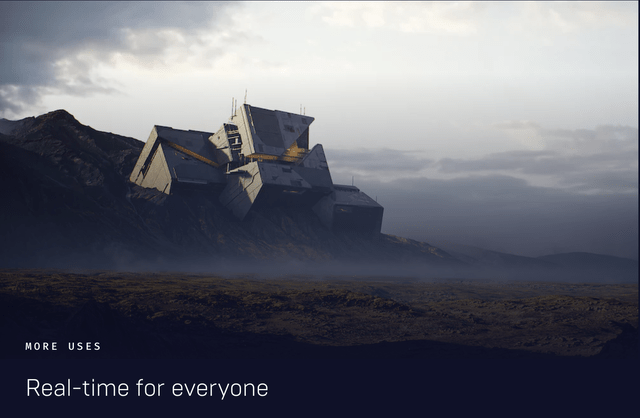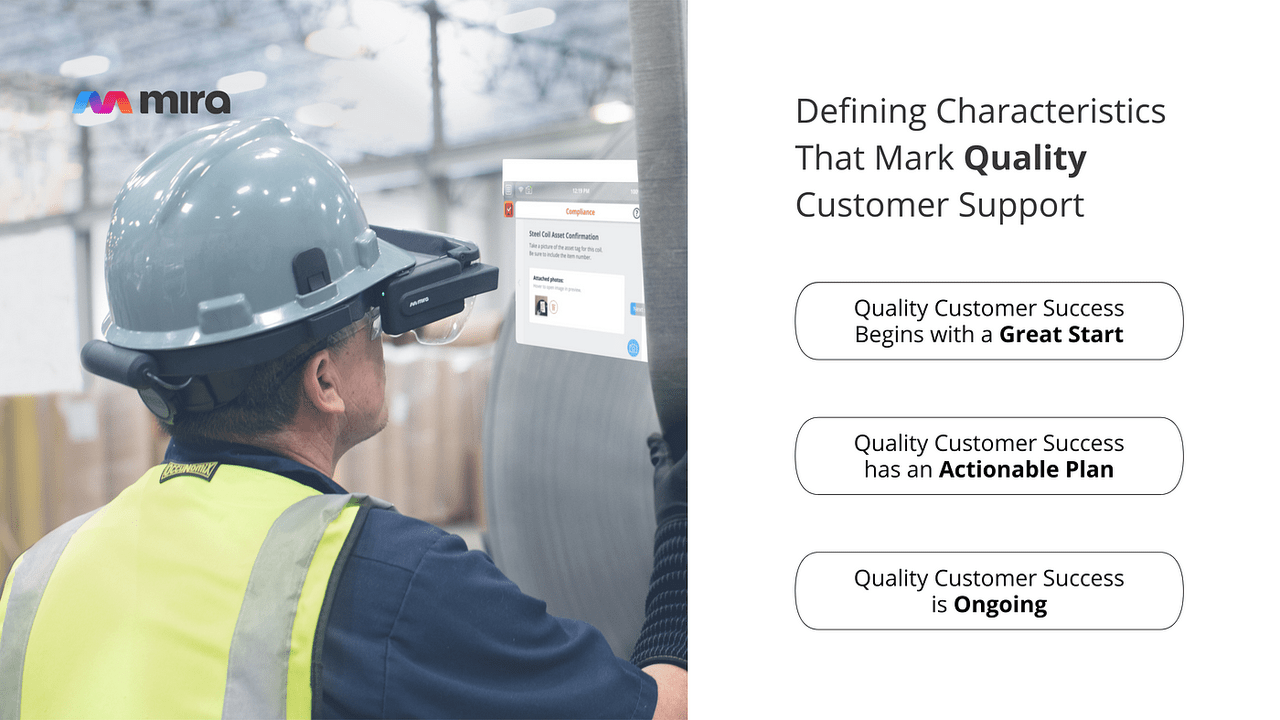Summary:
- Apple’s Vision Pro headset primarily targets retail customers, but recent news of their acquisition of Mira indicates a potential focus on the enterprise market as well.
- Apple’s partnership with Disney is a strategic move that taps into the family market, enabling immersive entertainment experiences for families using multiple headsets.
- Apple’s partnership with Unity is confusing considering the target audience of affluent consumers who might expect more advanced and realistic experiences.
- Apple needs to provide a compelling solution for enterprise customers and learn from past experiences to ensure Vision Pro’s success in the market.
mikkelwilliam
Introduction
Upon reviewing the presentation, it became evident that Apple’s (NASDAQ:AAPL) Vision Pro headset is primarily aimed at retail customers.
However, our attention was drawn to recent news that Apple recently made headlines with its acquisition of Mira, an augmented reality start-up known for its technology used in diverse applications in the enterprise market.
In this article, we would like to explore its potential and evaluate its strategy for retail and enterprise markets, respectively.
Retail market can be larger than you think
With an initial price of $3500, Vision Pro is a product that caters to fervent consumers. While reports suggest Apple has reduced its sales target from 1 million to 150,000 units, we believe this to be a conservative estimate.
Contrary to popular belief, the retail market can be larger than anticipated, especially when targeting affluent consumers. These individuals are not solely motivated by practicality or necessity when making purchasing decisions. Instead, they seek out products and experiences that offer novelty, exclusivity, and a sense of luxury.
Furthermore, the affluent consumer market is known for its inclination to indulge in entertainment experiences with family and friends. Apple’s partnership with Disney, targeting the family market, is, in our opinion, a smart move. In this regard, the Vision Pro headset presents an opportunity for families to share the joy and excitement of immersive entertainment together. Imagine a family gathering where each member wears their own headset, exploring virtual worlds, engaging in interactive games, and enjoying movies in a whole new dimension.
This potential scenario not only has the ability to disrupt the TV and movie theater markets but also expands the addressable market for entertainment devices. Traditionally, households only needed one high-resolution 4K TV, but now they may require multiple Vision Pros to cater to each family member’s needs.
If, on average, a family purchases four units and even just the top 0.25% of the worldwide 2.2 billion households opt for this immersive experience, it could result in sales of 22 million units and a remarkable revenue increase of $77 billion in 2024, representing a substantial 20% growth. Assuming that the wealthy customer’s purchase is unrelated to its other purchase, no cannibalization will take place, and these growth estimates may even help to defend Apple’s 30-time P/E ratio.
The Partnership with Unity
During the press conference, it was revealed that Apple’s Vision Pro headset currently lacks third-party app development. To attract developers and suppliers, Apple made the strategic decision to partner with Unity. However, this move is confusing to us.
Unity is a widely recognized game development platform that has gained popularity among both indie and AAA developers. While Unity is known for its versatility and ability to create various types of games, it is primarily used by smaller companies. Some notable games developed with Unity include Pokémon Go, Monument Valley 2, and Among Us.
It’s worth noting that larger companies like Activision and Unreal Engine have their own platforms that offer more advanced technologies and models. Considering Apple’s target audience of affluent consumers, it would seem more natural for them to partner with Unreal Engine to develop entertainment experiences that are compatible with the immersive capabilities of Vision Pro. People would expect to witness realistic dinosaurs in Jurassic Park rather than play 3D Pokémon Go. However, it is worth mentioning that Tim Cook, Apple’s CEO, has previously expressed his personal fondness for Pokémon Go. Therefore, there is a level of anticipation for Apple to recreate a success story similar to that of Pokémon GO on its Vision Pro platform.
Overall, we are still cautious about this decision to partner with Unity and whether Apple has positioned itself in the right direction. It remains to be seen how the partnership will unfold and whether it will fulfill the expectations of the affluent consumer market.
Apple eyes on Enterprise Market
During its presentation, Apple showcased the capabilities of Vision Pro in aiding office workers to minimize their reliance on physical screens, keyboards, and mice. This demonstration hints at the potential for Vision Pro to enter the enterprise market. However, the presentation didn’t provide further details.
Using Apple Vision Pro in office setting (Apple)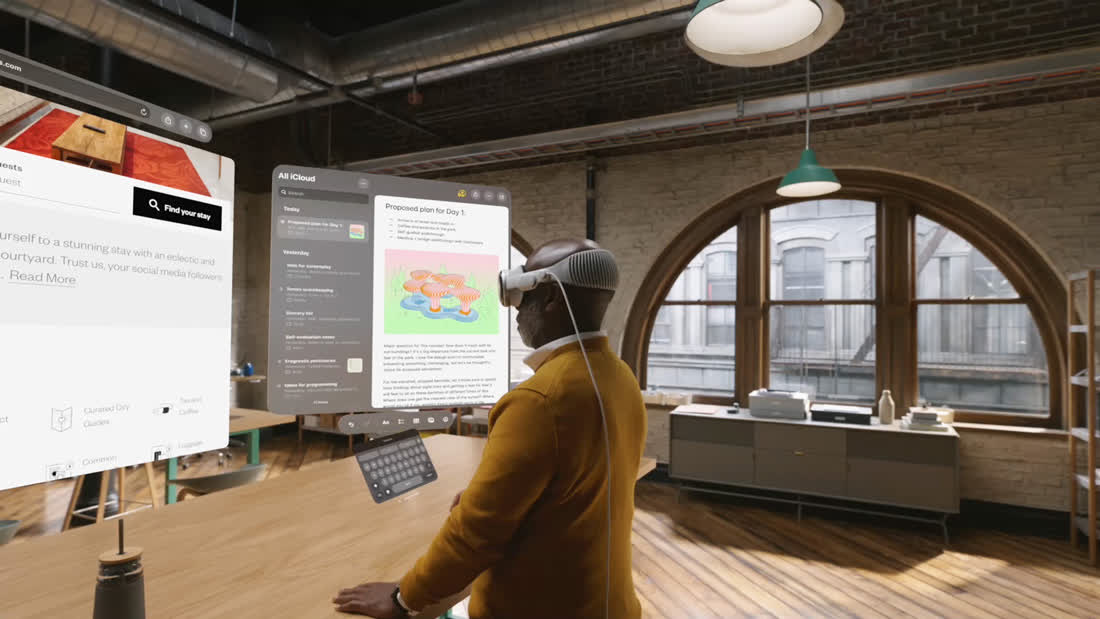
In addition, Apple recently made headlines with its acquisition of Mira, an augmented reality start-up known for its technology used in diverse industrial applications. Case studies have showcased fascinating examples of how Mira’s technology has revolutionized operations for various companies, breaking barriers and reducing the necessity for extensive travel. Professionals can now conduct remote audits effortlessly by wearing mixed reality headsets and immersing themselves in virtual environments, enabling them to inspect facilities from a distance. Similarly, remote engineering troubleshooting has become a reality, allowing experts to provide guidance and resolve issues without the need for physical presence.
In the enterprise market, HoloLens has established itself as the pioneer in augmented reality headsets. Additionally, when it comes to pricing, the Vision Pro is in a comparable range to the HoloLens.
| Headset | Price | Resolution |
|---|---|---|
| Vision Pro | $3500 | Possible 3800 x 3000 |
| HoloLens 2 | $3500 | 2048 x 1080 |
HoloLens (MSFT)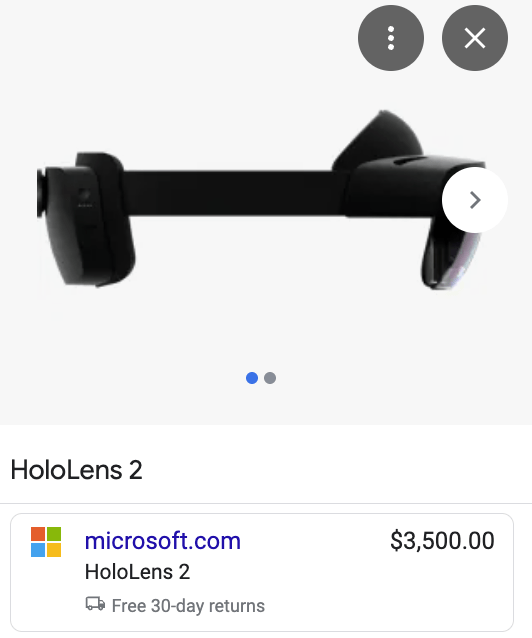
The HoloLens by Microsoft is an advanced augmented reality headset that targets enterprise customers. It has diverse applications in industries like business, where it aids in remote assistance, design visualization, and training simulations. In education and research, it provides interactive 3D models and simulations. The HoloLens also offers exciting opportunities for mixed reality gaming, integrating virtual elements into the user’s surroundings. Its capabilities have made it invaluable for professionals, students, and researchers alike, revolutionizing their work and exploration.
Hololens (MSFT)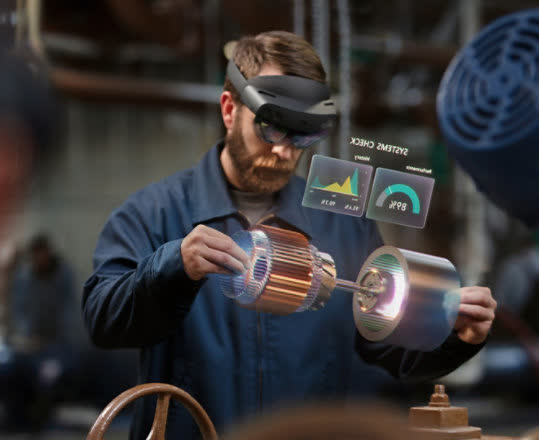
The Vision Pro headset, priced at $3,500, can be a practical and cost-effective investment for businesses. It offers an alternative that is more economical compared to the exorbitant costs associated with air travel and accommodations for business trips. Statistics from the Global Business Travel Association show that global business travel spending amounted to an astounding $933 billion in 2022. Reflecting on this revelation, we envisioned the immense potential of MR headsets to reduce just 1% of this colossal expenditure. The calculations revealed an astonishing annual saving of $140 billion, a valuable resource that could be allocated to other endeavors.
Another attractive use case for the Vision Pro headset lies in its adoption by the US military. In fact, the US Army had embraced the potential of mixed-reality technology, with the iconic Microsoft HoloLens headsets playing a pivotal role in their operations. The military organization has acknowledged the value of MR technology and has integrated it into its training programs for diverse purposes. In 2022, the Department of Defense received a substantial amount of funding, totaling $291 billion, for its operations and maintenance. This allocation presents significant opportunities and potential benefits for the Vision Pro.
US army to use HoloLens (MSFT)
HoloLens faced growth challenges
However, HoloLens has encountered its own set of challenges. This indicates that Vision Pro may encounter similar challenges as it expands into the enterprise market.
On February 10, 2023, Microsoft confirmed that it would be laying off employees involved in HoloLens, Surface, and Xbox products. Additionally, reports have surfaced indicating that the industrial metaverse unit will be cut, leading to the closure of that team. These decisions came as Microsoft faced macroeconomic uncertainties and slower growth.
The reasons behind these layoffs can only be speculated upon. One possible reason could be intense competition due to the presence of numerous alternatives. Mira’s case studies have revealed that, although the cost savings associated with air travel are enticing, there are numerous alternative methods available. Instead of buying and setting up a whole system for an AR/MR device, remote engineering troubleshooting can be handled using teleconference calls, or internet of things solutions with sensor technology as alternatives.
Utilize video conferencing tools to establish real-time communication between remote engineers and on-site personnel. This allows engineers to visually assess the situation, observe equipment or systems, and guide on-site technicians through troubleshooting steps. Equip the equipment or systems with IoT-enabled sensors that can transmit real-time data and diagnostics. Engineers can remotely access this data, analyze it, and provide troubleshooting guidance based on the information received.
In addition, combining business travel with business development trips can prove economically beneficial as well. Therefore, despite the fact that AR/MR devices can benefit employees, they are not a must-have.
Similar to HoloLens, Apple has yet to present a compelling case for the use of Vision Pro in the enterprise sector.
Criticism
There are valid concerns raised by individuals regarding the limited battery life and weight of the Vision Pro headset. However, we believe that these issues may not be deal-breakers if the headset can generate sufficient economic value, particularly for enterprise customers.
Take military training for troops as an example. If the Vision Pro proves to be invaluable in enhancing the training experience and improving soldiers’ skills, the weight of the helmet becomes less significant. Soldiers recognize the importance of thorough training in potentially life-threatening situations, where the ability to avoid fatal mistakes on the battlefield can make a crucial difference.
Similarly, if the Vision Pro effectively addresses the needs of office workers and significantly boosts productivity, the limited battery life can be considered acceptable in such a scenario. The potential increase in output and efficiency resulting from the use of the headset may outweigh the inconvenience of a shorter battery life.
Moreover, it’s important to consider the long-term benefits and cost savings that can be achieved through these use cases. If the Vision Pro proves to be an essential tool in military training or office productivity, the cumulative savings and advantages could easily surpass the initial investment cost of $3500 per headset.
Catalyst
Apple’s stock didn’t experience significant movement following the launch of Vision Pro, as the market perceived it to have minimal impact on Apple’s revenues and valuation. However, we view this as an opportunity for investors. The release of sales or preorder numbers for Vision Pro could potentially act as a catalyst for the stock.
Based on our analysis, we believe that the affluent consumer market for Vision Pro could be larger than expected, particularly considering its potential for family use.
Additionally, Apple’s acquisition of Mira has sparked a potential opportunity in the enterprise market. Therefore, we encourage investors to closely monitor Apple’s strategies for the application of Vision Pro in the enterprise market, as this could serve as a potential catalyst for growth as well.
Conclusion
Apple’s Vision Pro headset presents opportunities in both the retail and enterprise markets. Despite the initial perception that the retail market may not be substantial, targeting affluent consumers who value luxury and novelty can yield significant sales and revenue growth. The partnership with Disney further enhances this potential by providing immersive entertainment experiences for families. Our analysis shows that the high end consumer market can be as large as $77 billion in 2024. However, we remained cautious about Apple’s partnership with Unity.
In the enterprise market, Vision Pro has the potential to revolutionize operations and reduce costs. However, Apple needs to provide a compelling case for Vision Pro’s adoption in the enterprise market.
Valid concerns about battery life and weight have been raised, but if Vision Pro can deliver sufficient economic value, especially for enterprise customers, these issues may be overshadowed.
Overall, while challenges and uncertainties remain, Vision Pro presents a unique opportunity for Apple to establish a foothold in the emerging market of mixed reality headsets and tap into the potential of both consumer and enterprise applications.
Analyst’s Disclosure: I/we have no stock, option or similar derivative position in any of the companies mentioned, and no plans to initiate any such positions within the next 72 hours. I wrote this article myself, and it expresses my own opinions. I am not receiving compensation for it (other than from Seeking Alpha). I have no business relationship with any company whose stock is mentioned in this article.
Seeking Alpha’s Disclosure: Past performance is no guarantee of future results. No recommendation or advice is being given as to whether any investment is suitable for a particular investor. Any views or opinions expressed above may not reflect those of Seeking Alpha as a whole. Seeking Alpha is not a licensed securities dealer, broker or US investment adviser or investment bank. Our analysts are third party authors that include both professional investors and individual investors who may not be licensed or certified by any institute or regulatory body.

